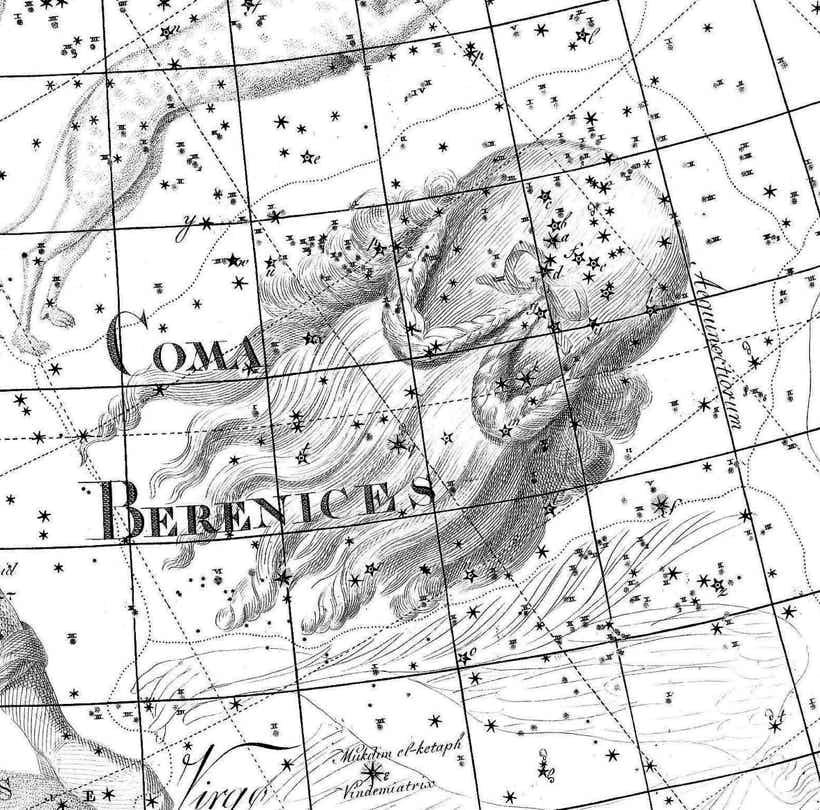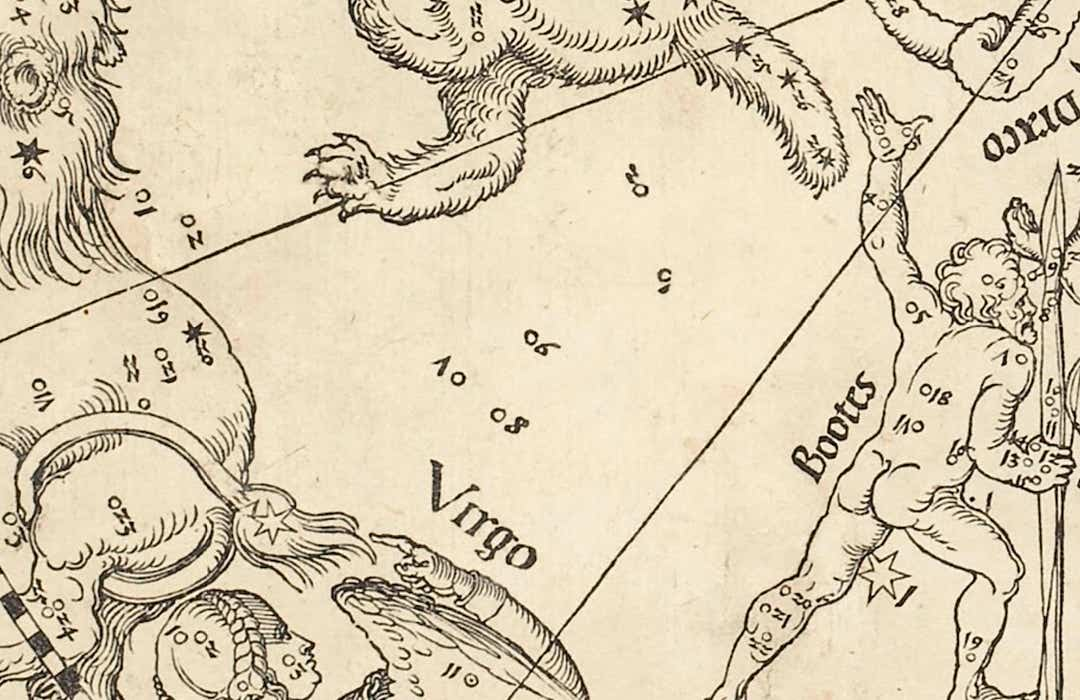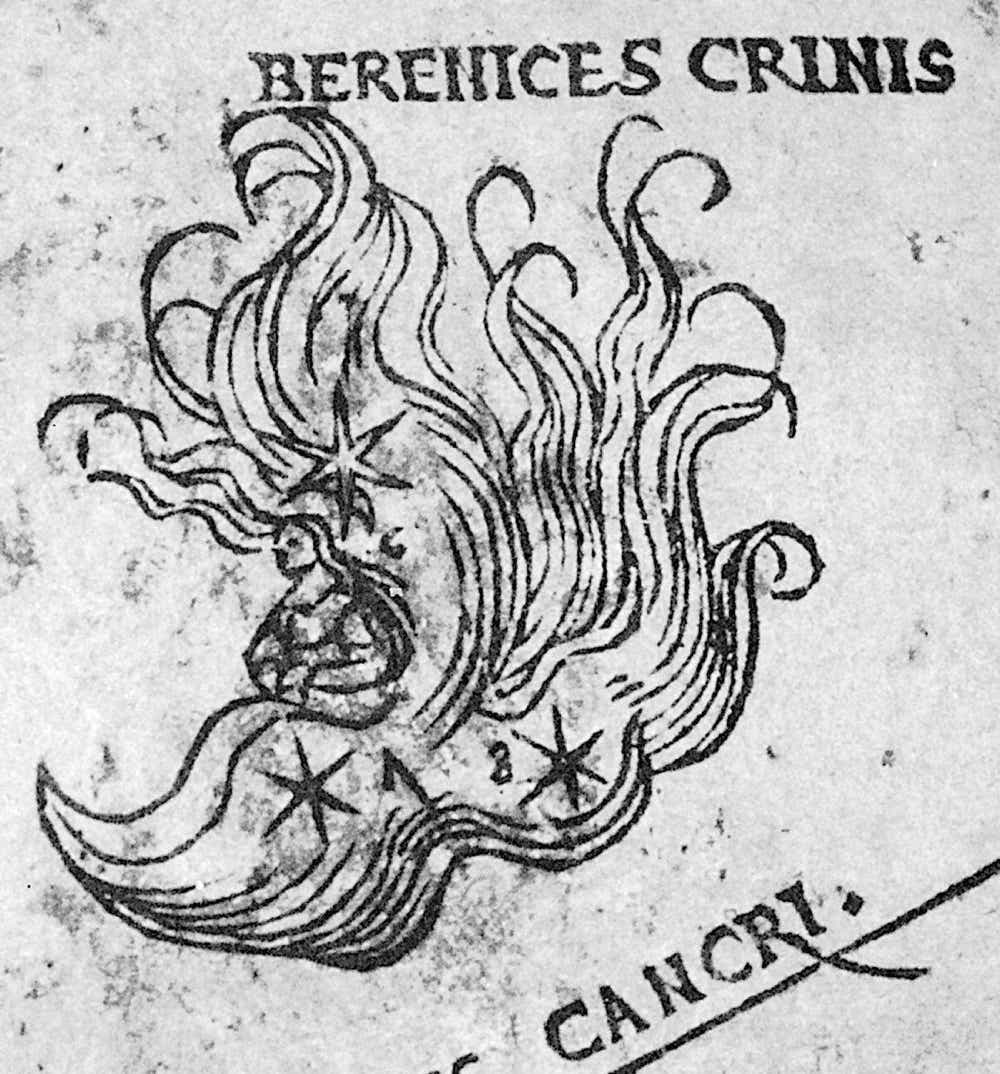
Genitive: Comae Berenices
Abbreviation: Com
Size ranking: 42nd
Origin: Caspar Vopel
Between Boötes and Leo lies a fan-shaped swarm of faint stars that was known to the Greeks but was not classed by them as a separate constellation. Eratosthenes referred to this swarm as the hair of Ariadne under his entry on the Northern Crown (Corona Borealis), but under Leo he said it was the hair of Queen Berenice of Egypt, which is how we identify it today.
Ptolemy, at the end of his Almagest entry on Leo, listed three ‘unformed’ stars outlining the swarm, which he described as ‘a nebulous mass, called the lock’, i.e. of hair. (Ptolemy used the word Πλόκαμος – Plokamos in Latin transliteration – which can also be translated as tress or braid as well as lock). This triangle of stars can be seen, for example, on Albrecht Dürer’s star chart of 1515, above the tail of Leo and behind the rear legs of the Great Bear. We know them today as Gamma, 7, and 23 Comae Berenices.
To the third star Ptolemy added the curious description ‘shaped like an ivy leaf’, presumably referring to the overall shape of the trio and the nebulous mass within. Nine centuries later, the Persian astronomer/astrologer al-Bīrūnī (973–1048) echoed this description in his Kitāb al-Tafhīm, writing that this group of stars resembled ‘a cloud shaped like an ivy-leaf’. As a result of these descriptions, in medieval times this triangular grouping was sometimes depicted as an ivy leaf above the tail of Leo.
The group was first shown as a separate constellation in 1536, under the name Berenices Crinis, on a globe by the German mathematician and cartographer Caspar Vopel (1511–61). He was followed by the Dutch cartographer Gerardus Mercator (1512–94), who termed the constellation Cincinnus, a Latin word meaning lock of hair, on a celestial globe he made in 1551. In 1602 Tycho Brahe included Coma Berenices in his influential star catalogue, thus ensuring its widespread adoption. The constellation as envisaged by Vopel, Mercator, and Tycho covers a much larger area than the nebulous mass described by Ptolemy, which is now known as the cluster Melotte 111.
The modern constellation’s three brightest stars, all of fourth magnitude, were labelled Alpha, Beta, and Gamma by Francis Baily in his British Association Catalogue of 1845.
Coma Berenices, the flowing tresses of an Egyptian queen, from Chart VII of the Uranographia of Johann Bode (1801). The ‘nebulous mass’ described by Ptolemy that formed the basis of the constellation (actually a scattering of faint stars) is in the upper right part of the illustration, on the crown of the hair.
A hair-raising story
Berenice was a real person who, in 246 BC, married her cousin, Ptolemy III Euergetes (Hyginus says she was his sister, but that was a different Berenice). Berenice was reputedly a great horsewoman who had already distinguished herself in battle. Hyginus, who deals with the star group under Leo in his Poetic Astronomy, tells the following story.
It seems that shortly after their marriage (Hyginus says a few days, but in reality it was a few months) Ptolemy set out to attack Asia on the Third Syrian War. Berenice vowed that if he returned victorious she would cut off her hair in gratitude to the gods. On Ptolemy’s safe return the following year, the relieved Berenice carried out her promise and placed her hair in the temple dedicated to her mother Arsinoë (identified after her death with Aphrodite) at Zephyrium near the modern Aswan. But the following day the tresses were missing. What really happened to them is not recorded, but Conon of Samos (c.280–c.220 BC), a mathematician and astronomer who worked at Alexandria, pointed out the group of stars near the tail of the lion, telling the king that the hair of Berenice had gone to join the constellations.
In reality, the disappearance of the hair and its subsequent ‘discovery’ among the stars was most likely staged to glorify Ptolemy and his queen among their subjects. The story was mythologized by the court poet Callimachus (c.305–c.240 BC) in his popular poem called Lock of Berenice.
Chinese associations
Chinese astronomers plotted 15 stars of the Coma Star Cluster which they called Langwei, a group of court officials that included various scholars, advisors, and bodyguards. To the north was a single star called Langjiang, captain of the bodyguards, most likely Gamma Comae Berenices although it is also identified by some as 31 Com or even Alpha Canum Venaticorum. Beta, 37, and 41 Com formed Zhouding, representing a three-legged bronze food vessel (although an earlier tradition placed Zhouding in Boötes).
Alpha Comae Berenices was the northernmost star in a chain of five that extended southwards into Virgo; this chain marked the eastern wall of Taiwei, a court where the Emperor met with his privy council. Five faint stars in southern Coma Berenices, identities uncertain, formed Nei wuzhuhou, representing five feudal lords or princes who governed various outlying states, here seen gathered within the court of Taiwei. Other constellations within the court were in present-day Virgo and Leo.
© Ian Ridpath. All rights reserved
The triangle of stars outlining the ‘nebulous mass’ described by Ptolemy between Leo and Ursa Major, as shown on Albrecht Dürer’s northern celestial hemisphere chart of 1515. Dürer has numbered these stars 6, 7, and 8, as they are the 6th, 7th and 8th of the ‘unformed’ stars that Ptolemy listed as lying outside Leo. They are now designated Gamma, 7, and 23 Comae Berenices. The two free-floating stars farther north, under the hind quarters of Ursa Major, formed the basis for another non-Ptolemaic constellation, Canes Venatici. See also Ptolemy’s spare stars.
Big hair: the miniature figure of Berenice at the centre of Ptolemy’s three stars is engulfed by her flowing locks, as drawn on Caspar Vopel’s globe of 1536. See Caspar Vopel's Ventures in Sixteenth-Century Celestial Cartography by Elly Dekker. Image courtesy Cologne City Museum.





